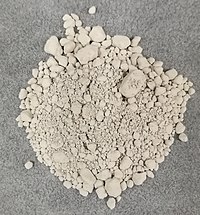
Chemical speciation and leaching characteristics of hazardous trace elements in coal and fly ash from coal-fired power plants
Sign Up to like & getrecommendations! Published in 2018 at "Fuel"
DOI: 10.1016/j.fuel.2018.05.135
Abstract: Abstract This work reports the chemical speciation and leaching characteristics of seven hazardous trace elements (HTEs, including Hg, As, Cr, Cd, Ba, Mn, and Pb) in the coal and fly ash samples collected from four… read more here.
Keywords: coal; leaching characteristics; fly ash; chemical speciation ... See more keywords

Speciation of the trivalent f-elements Eu(III) and Cm(III) in digestive media.
Sign Up to like & getrecommendations! Published in 2017 at "Journal of inorganic biochemistry"
DOI: 10.1016/j.jinorgbio.2017.07.020
Abstract: In case radioactive materials are released into the environment, their incorporation into our digestive system would be a significant concern. Trivalent f-elements, i.e., trivalent actinides and lanthanides, could potentially represent a serious health risk due… read more here.
Keywords: speciation trivalent; trivalent elements; digestive media; speciation ... See more keywords

Dual wave β-correction spectrophotometry for trace determination and chemical speciation of As(III)/As(V) in water
Sign Up to like & getrecommendations! Published in 2020 at "Microchemical Journal"
DOI: 10.1016/j.microc.2020.105856
Abstract: Abstract A facile and low-cost strategy for trace determination and chemical speciation of As(III) and As(V) has been developed via dual wave β-correction spectrophotometry. As(III) in the presence of chromogenic reagent zincon forms a purple… read more here.
Keywords: determination chemical; determination; trace determination; speciation iii ... See more keywords

A Critical Review on Chemical Speciation of Chlorine-Produced Oxidants (CPOs) in Seawater. Part 2: Sampling, Sample Preparation and Non-Chromatographic and Mass Spectrometric-Based Methods.
Sign Up to like & getrecommendations! Published in 2022 at "Critical reviews in analytical chemistry"
DOI: 10.1080/10408347.2022.2135984
Abstract: Chlorination of seawater forms a range of secondary oxidative species, collectively termed "chlorine-produced oxidants" (CPOs). These compounds do not have the same biocidal efficacy, the same fate and behavior in the marine environment, the same… read more here.
Keywords: cpos seawater; chemical speciation; produced oxidants; oxidants cpos ... See more keywords

Chemical Speciation of Copper in a Salt Marsh Estuary and Bioavailability to Thaumarchaeota
Sign Up to like & getrecommendations! Published in 2017 at "Frontiers in Marine Science"
DOI: 10.3389/fmars.2017.00178
Abstract: The concentrations of dissolved copper (Cud), copper-binding ligands, thiourea-type thiols and humic substances (HSCu) were measured in estuarine waters adjacent to Sapelo Island, Georgia, USA, on a monthly basis from April to December 2014. Here… read more here.
Keywords: copper salt; copper; thiourea type; speciation copper ... See more keywords

8-Hydroxyquinoline-2-Carboxylic Acid as Possible Molybdophore: A Multi-Technique Approach to Define Its Chemical Speciation, Coordination and Sequestering Ability in Aqueous Solution
Sign Up to like & getrecommendations! Published in 2020 at "Biomolecules"
DOI: 10.3390/biom10060930
Abstract: 8-hydroxyquinoline-2-carboxylic acid (8-HQA) has been found in high concentrations (0.5–5.0 mmol·dm−3) in the gut of Noctuid larvae (and in a few other lepidopterans), in which it is proposed to act as a siderophore. Since it… read more here.
Keywords: carboxylic acid; hydroxyquinoline carboxylic; sequestering ability; speciation ... See more keywords

Steam Gasification of Sawdust Biochar Influenced by Chemical Speciation of Alkali and Alkaline Earth Metallic Species
Sign Up to like & getrecommendations! Published in 2018 at "Energies"
DOI: 10.3390/en11010205
Abstract: The effect of chemical speciation (H 2 O/NH 4 Ac/HCl-soluble and insoluble) of alkali and alkaline earth metallic species on the steam gasification of sawdust biochar was investigated in a lab-scale, fixed-bed reactor, with the… read more here.
Keywords: soluble aaems; biochar; steam gasification; gasification ... See more keywords

Enrichment and Chemical Speciation of Vanadium and Cobalt in Stone Coal Combustion Products in Ankang, Shanxi Province, China
Sign Up to like & getrecommendations! Published in 2022 at "International Journal of Environmental Research and Public Health"
DOI: 10.3390/ijerph19159161
Abstract: Stone coal enriches more elements compared to other coals, especially Vanadium (V). The content of Co is relatively low, while its environmental risk is relatively high. This study collected the stone-coal samples to investigate the… read more here.
Keywords: combustion products; coal; combustion; chemical speciation ... See more keywords

New Coumarin Dipicolinate Europium Complexes with a Rich Chemical Speciation and Tunable Luminescence
Sign Up to like & getrecommendations! Published in 2021 at "Molecules"
DOI: 10.3390/molecules26051265
Abstract: Europium (III) luminescent chelates possess intrinsic photophysical properties that are extremely useful in a wide range of applications. The lack of examples of coumarin-based lanthanide complexes is mainly due to poor photo-sensitization attempts. However, with… read more here.
Keywords: rich chemical; europium; dipicolinate europium; coumarin dipicolinate ... See more keywords